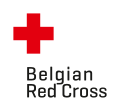| Croix-Rouge de Belgique Belgische Rode Kruis Belgisches Rotes Kreuz | |
 International logo of the Flemish Red Cross (using the name Belgian Red Cross) | |
 Official insignia of the Belgian Red Cross | |
| Formation | February 4, 1864 |
|---|---|
| Founded at | Brussels |
| BE0406729809 | |
| Registration no. | 0406729809 |
| Legal status | Non-Governmental Organisation |
| Headquarters | Brussels, Belgium |
| Subsidiaries | Rode Kruis-Vlaanderen |
| Affiliations | International Federation of Red Cross and Red Crescent Societies |
| Volunteers | 24.340 (2023) |
| Website | www |
The Belgian Red Cross is a humanitarian organization that aids in providing emergency and disaster related services and relief as well as providing education for disaster awareness within the population of Belgium. It is a member of the International Federation of Red Cross and Red Crescent Societies.
